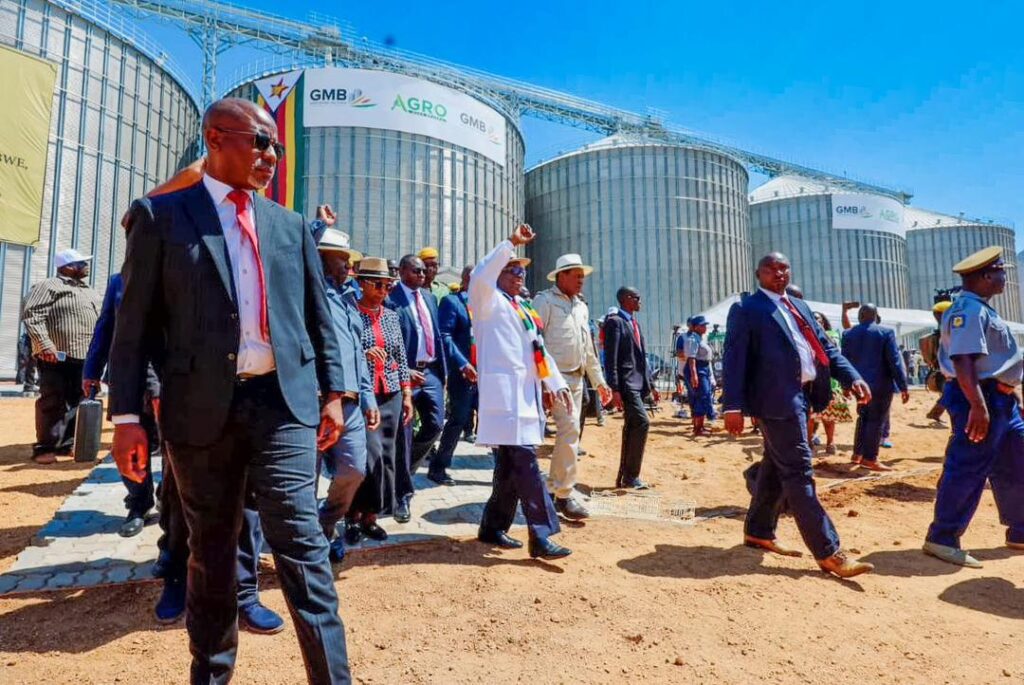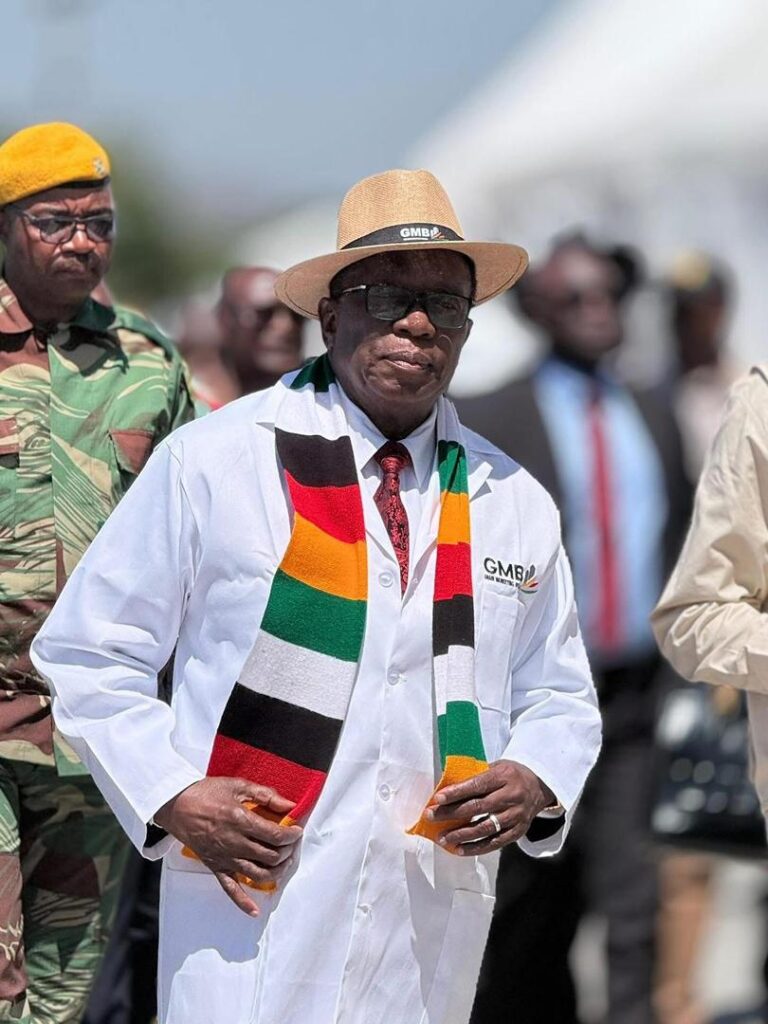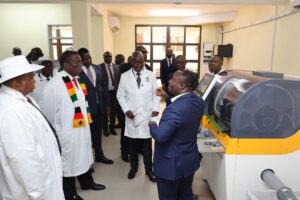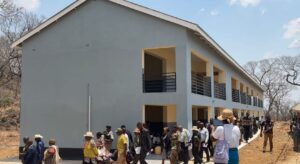President Mnangagwa Commissions AI-Driven Grain Silos in Mutare
4 min read
Modern storage facilities boost food security and agricultural digital transformation
Mutare – Zimbabwe today marked a major milestone in its agricultural transformation journey as His Excellency President Dr. Emmerson Dambudzo Mnangagwa officially commissioned seven AI-driven grain silos at the Grain Marketing Board (GMB) Mutare Depot in Manicaland Province.
Each state-of-the-art silo has a storage capacity of 8,000 metric tonnes, bringing the total holding capacity at the depot to 56,000 metric tonnes of grain.
The Mutare commissioning comes just months after the launch of similar AI-enabled silos at the Kwekwe Depot, making Manicaland the second province to operationalise this new generation of intelligent post-harvest storage infrastructure.

This initiative is part of the Second Republic’s National Grain Storage Expansion Programme, which aims to establish 14 such facilities nationwide within the next two years.
In his keynote address, President Mnangagwa said the commissioning of AI-enabled silos represents more than an infrastructure upgrade—it is a transformative step in securing Zimbabwe’s food sovereignty.
“A nation that cannot feed itself is not truly independent. These intelligent silos are a strategic investment in national food security and agricultural modernisation. We will never again be victims of food imports or hunger,” said President Mnangagwa.
He reaffirmed government commitment to supporting farmers and ensuring that surplus grain is stored scientifically to retain quality for both strategic reserves and market supply.
“This project supports our journey under the National Development Strategy 1 (NDS1) and lays a strong foundation towards an upper-middle income economy by 2030,” he added.
These are not ordinary silos. They integrate Artificial Intelligence (AI), Internet of Things (IoT) sensors, and automated grain management systems. Inside each silo, smart sensors continuously monitor Temperature, Moisture levels, Grain weight, Aeration quality, Carbon Dioxide levels to detect spoilage or pests.
AI software instantly analyses data and can automatically trigger actions like ventilation, aeration, or grain rotation to prevent spoilage—reducing post-harvest grain losses by up to 50%.
Technicians and depot managers can monitor silo performance using real-time dashboards and mobile apps, making grain management safer and more efficient.
Speaking at the event, Grain Marketing Board (GMB) chief executive Mr Edson Badarai explained the direct benefits to farmers.
“Farmers lose millions every year due to poor grain storage, but this technology eliminates those losses. Farmers can now store maize, sorghum and wheat safely for longer. This will increase their earnings,” he said.
The AI silos also improve grain quality control, ensuring that Zimbabwe meets exporting standards for regional markets such as Mozambique, Zambia, Malawi and the Democratic Republic of Congo (DRC).
Enhanced storage capacity also means the Strategic Grain Reserve (SGR) can be comfortably maintained throughout drought seasons caused by El Niño and climate change effects.
President Mnangagwa said the project will not only benefit Manicaland but also stimulate rural industrialisation and local employment.
“The development we seek leaves no province and no community behind. The grain value chain must create jobs, rural industries and market access for our farmers,” he said.
The Mutare silo project created over 150 jobs during construction and will support hundreds of livelihoods through related services such as grain logistics, mechanical maintenance, ICT engineering and silo operations.
Farmers who attended the commissioning ceremony expressed joy that Manicaland—one of Zimbabwe’s top maize and traditional grains producers—has received world-class storage infrastructure.
Mrs. Rumbidzai Mawoyo, a small-scale farmer from Mutasa District, said the AI silos came at the right time.
“We used to lose up to 20 bags of maize to weevils and moisture every season. Now we can deliver our grain to GMB early and store it without fear. This is progress we can see and feel,” she said.
Large-scale wheat farmer Mr. David Mupotsa from Nyanga said the project boosts farmer confidence.
“This is proof that government is serious about agriculture. With smart irrigation, PFumvudza inputs, and now smart grain storage, our work as farmers is being supported,” he said.
Agricultural technologist Dr. Tatenda Govera described the project as a breakthrough in Africa’s agriculture digitalisation journey.
“Zimbabwe has joined a small but growing number of African countries—like South Africa and Egypt—that use AI in food security systems. This will reduce national grain losses, which currently average 30% in sub-Saharan Africa,” he said.
He noted that the silos are equipped to handle not just maize and wheat but also sorghum, millet and rice—key crops in climate-resilient farming.
The President said agriculture remains a key pillar of Zimbabwe’s journey toward Vision 2030 – Creating an Upper Middle Income Economy by the Year 2030.
He reminded stakeholders that Zimbabwe recently achieved a record wheat harvest and continues to expand irrigation farming, dam construction, and rural mechanisation.
“We must feed ourselves first and feed the region next. Zimbabwe is rising again,” said the President.
The silo commissioning aligns with government’s Smart Agriculture Blueprint, which promotes use of modern technology in all farming stages—from soil testing and planting to harvesting and storage.
Farmers will soon receive training on using digital scales, online delivery systems, and e-voucher systems at GMB depots.
The Minister of Lands, Agriculture, Fisheries, Water and Rural Development Dr. Anxious Masuka said the AI silos will help Zimbabwe build secure strategic grain reserves, especially in drought periods.
“These silos are a critical investment in our long-term food resilience. They will ensure our grain reserves remain safe, clean and market-ready,” he said.
The commissioning of the Mutare AI-driven silos marks a historic leap for Zimbabwe’s agricultural future—combining science, food security, digital technology and rural empowerment.
As the nation continues to invest in modern agriculture, Zimbabwe is positioning itself as Southern Africa’s grain powerhouse.
With bold policies, technological innovation and farmer-driven productivity, Zimbabwe’s path to Vision 2030 is taking shape on solid ground.




